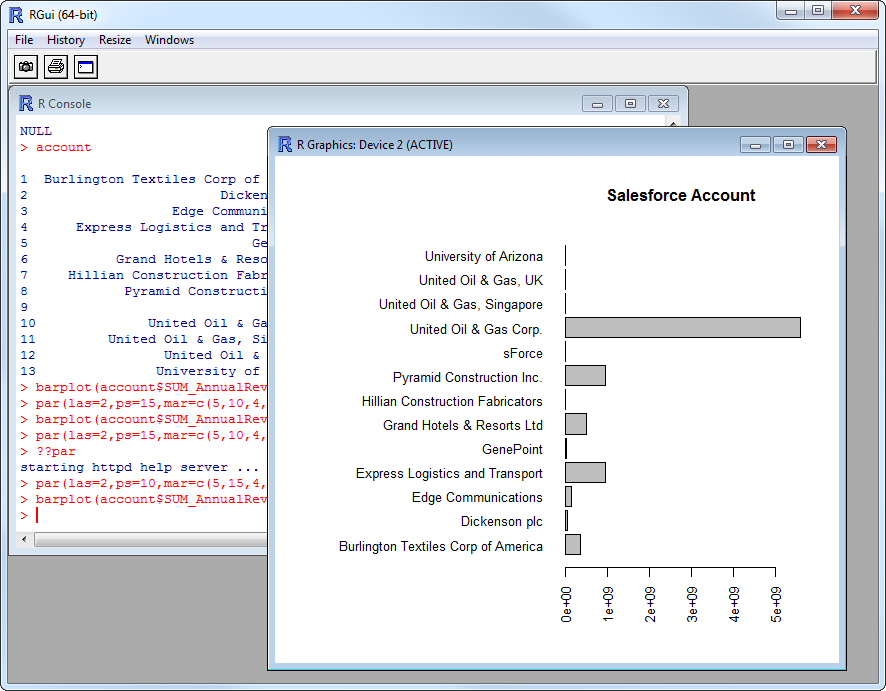Model Context Protocol (MCP) finally gives AI models a way to access the business data needed to make them really useful at work. CData MCP Servers have the depth and performance to make sure AI has access to all of the answers.
Try them now for free →Analyze Phoenix Data in R
Use standard R functions and the development environment of your choice to analyze Phoenix data with the CData JDBC Driver for Phoenix.
Access Phoenix data with pure R script and standard SQL on any machine where R and Java can be installed. You can use the CData JDBC Driver for Phoenix and the RJDBC package to work with remote Phoenix data in R. By using the CData Driver, you are leveraging a driver written for industry-proven standards to access your data in the popular, open-source R language. This article shows how to use the driver to execute SQL queries to Phoenix and visualize Phoenix data by calling standard R functions.
Install R
You can match the driver's performance gains from multi-threading and managed code by running the multithreaded Microsoft R Open or by running open R linked with the BLAS/LAPACK libraries. This article uses Microsoft R Open 3.2.3, which is preconfigured to install packages from the Jan. 1, 2016 snapshot of the CRAN repository. This snapshot ensures reproducibility.
Load the RJDBC Package
To use the driver, download the RJDBC package. After installing the RJDBC package, the following line loads the package:
library(RJDBC)
Connect to Phoenix as a JDBC Data Source
You will need the following information to connect to Phoenix as a JDBC data source:
- Driver Class: Set this to cdata.jdbc.apachephoenix.ApachePhoenixDriver
- Classpath: Set this to the location of the driver JAR. By default this is the lib subfolder of the installation folder.
The DBI functions, such as dbConnect and dbSendQuery, provide a unified interface for writing data access code in R. Use the following line to initialize a DBI driver that can make JDBC requests to the CData JDBC Driver for Phoenix:
driver <- JDBC(driverClass = "cdata.jdbc.apachephoenix.ApachePhoenixDriver", classPath = "MyInstallationDir\lib\cdata.jdbc.apachephoenix.jar", identifier.quote = "'")
You can now use DBI functions to connect to Phoenix and execute SQL queries. Initialize the JDBC connection with the dbConnect function.
Connect to Apache Phoenix via the Phoenix Query Server. Set the Server and Port (if different from the default port) properties to connect to Apache Phoenix. The Server property will typically be the host name or IP address of the server hosting Apache Phoenix.
Authenticating to Apache Phoenix
By default, no authentication will be used (plain). If authentication is configured for your server, set AuthScheme to NEGOTIATE and set the User and Password properties (if necessary) to authenticate through Kerberos.
Built-in Connection String Designer
For assistance in constructing the JDBC URL, use the connection string designer built into the Phoenix JDBC Driver. Either double-click the JAR file or execute the jar file from the command-line.
java -jar cdata.jdbc.apachephoenix.jar
Fill in the connection properties and copy the connection string to the clipboard.

Below is a sample dbConnect call, including a typical JDBC connection string:
conn <- dbConnect(driver,"jdbc:apachephoenix:Server=localhost;Port=8765;")
Schema Discovery
The driver models Phoenix APIs as relational tables, views, and stored procedures. Use the following line to retrieve the list of tables:
dbListTables(conn)
Execute SQL Queries
You can use the dbGetQuery function to execute any SQL query supported by the Phoenix API:
mytable <- dbGetQuery(conn,"SELECT Id, Column1 FROM MyTable WHERE Id = '123456'")
You can view the results in a data viewer window with the following command:
View(mytable)
Plot Phoenix Data
You can now analyze Phoenix data with any of the data visualization packages available in the CRAN repository. You can create simple bar plots with the built-in bar plot function:
par(las=2,ps=10,mar=c(5,15,4,2))
barplot(mytable$Column1, main="Phoenix MyTable", names.arg = mytable$Id, horiz=TRUE)


